This week we continue our journey in one of the most mythical destinations in Greece, the beautiful island of Corfu. Located just a few kilometers off the northwestern coast of Greece, it is the second-largest of the Ionian Islands. The island has series of endless sandy beaches on the west coast, and pebbly beaches on the east coast, most of which are granted with the prestigious Blue Flag title for their crystal clear waters and well-equipped facilities.
Corfu is also one of the greenest islands in the Ionian Sea. It is estimated that the island is home to more than 1800 plant species, 300 bird species, and more than 40 mammals living inland or in the sea around it. Keep reading and check out our this week´s sailing itinerary just for you.

Sailing itinerary for Corfu
Day 1: Corfu Town – Sailing route Corfu-Petritis: +/- 12nm
Day 2: Petritis – Sailing route Petritis-Paxos: +/- 19,4nm
Day 3: Paxos – Sailing route Paxos-Parga: +/- 11nm
Day 4: Parga – Sailing route Parga-Sivota: +/- 13,2nm
Day 5: Sivota – Sailing route Sivota-Kalami: +/- 24,8nm
Day 6: Kalami – Sailing route Kalami-Corfu Town: +/- 7,2nm
Total distance: +/- 87,6 nautical miles
Day One: Corfu Town
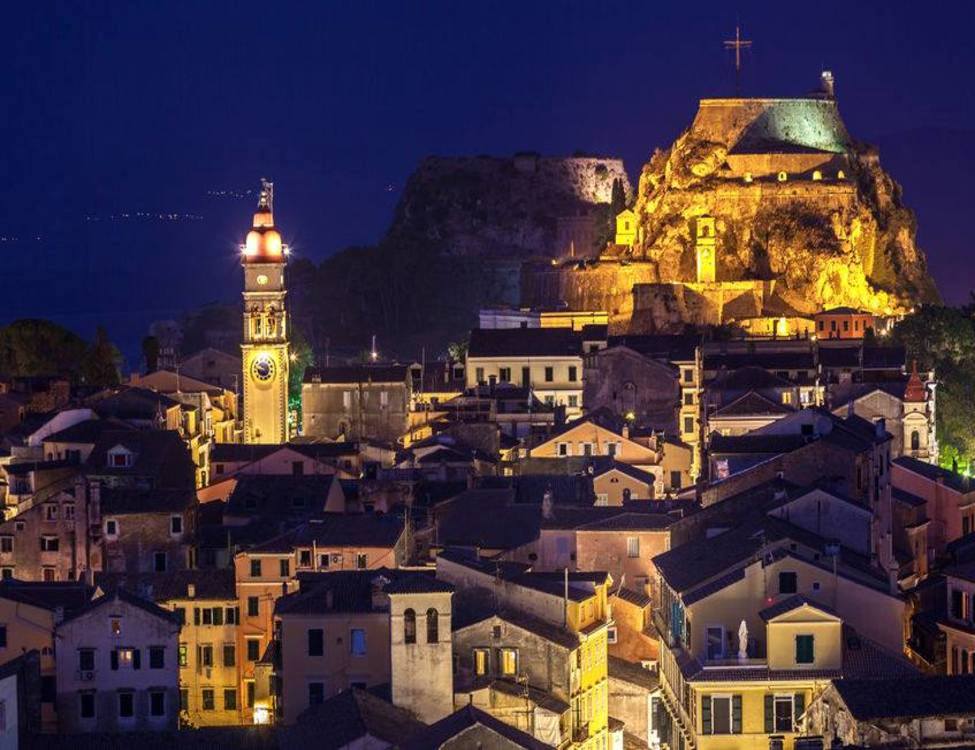
Day One: Corfu Town
- Most desired beaches:
Faliraki beach and Anemomilos beach are both good options for swimming nearby Corfu Town. The beaches are relatively small, with shallow water and a wide range of facilities, which attract tourists and locals alike for a nice stress-free day spending by the sea. A bit further away is Dassia Bay, a secluded bay surrounded by lush green vegetations. The beach here has a Blue Flag award thanks to its beautiful stretch of sand, and calm, shallow water, making it a great option for families with children. The beach also offers a wide range of water sports, such as water-skiing, wakeboarding, etc. Another good option for a family holiday is Kontokali Bay, which is located around 3 nautical miles north from Corfu Town. The beach is large and mostly sandy, with a wide range of facilities and amenities essential. If you’re searching for a more peaceful, laid-back atmosphere, we suggest set sail to Agios Ioannis Peristeron, around 6.5 nautical miles south from Corfu Town. Its distance from other crowded beach resorts has helped the area maintaining a really calm vibe. With a long stretch of sand and pebbles beach, crystal clear waters, and excellent facilities, the beach is one of our top options for a nice, stress-free holiday. - What not to miss:
While in Corfu Town, visitors should definitely check out some of the most popular attractions, such as the Old Fortress, which is a natural fortress on the eastern edge of the Old Town. It was used by the Byzantines since the 5th century AD as a natural fortification and remains one of the most valuable heritage of Corfu till this day. From the fortress’ highest point, which is marked by a lighthouse, visitors will have a magnificent view of the town and even Albania across the sea. Other worth-noticing sights include the 19th-century square of Spianada – the largest square in the Balkans, the characteristic arcade of Liston, Saint Michael and George Palace, and the Church of St. Spyridon. If you’re looking for a nice escape from the crowd, we would also recommend visiting the islet of Pontikonisi. Located just off the southern tip of the center, this picturesque islet is covered by a cluster of cypress trees, creating a small greenly paradise for boaters. - Berthing:
There are three berthing options in Corfu:1. Gouvia Marina (39°39.227’N, 019°51.073’E) is located around 6km from Corfu Town. The marina offers around 1235 berths on both permanent and floating pontoons, as well as dry dock facilities for around 520 boats. Moorings are available for boats up to 80 meters long and with 5.5 meters draught. Electricity is available at all berths. The marina is also very well-equipped with a wide range of facilities and services, including 24/7 security, wifi, fuel station, engine maintenance and repair, and even diving services.
2. Mandraki harbor (39°37.480’N, 019°55.650’E) is located under the N wall of the Venetian fortress. The harbor is well protected from the prevailing NW winds, offering laid moorings for around 60 yachts. The berths are distributed between the S quay and N breakwater. Depths at the quay are from 1.5 – 3 meters, and at the breakwater are from 1.25 – 1.5 meters. The shelter is good in prevailing winds but can get uncomfortable in very strong NW winds.
3. NAOK harbor (39°37.230’N, 019°55.530’E) is located on the S side of the Venetian castle. The harbor is relatively shallow, with depths from 2.5 to 3 meters. There are 4-5 laid moorings for visiting yachts on the eastern part of the breakwater quay. Water and electricity are available on the quay. The harbor is also well equipped with essentials like showers, toilet, wifi, cafes, etc. The shelter is good in prevailing winds but gets untenable in strong southerly winds.
Day Two: Petritis
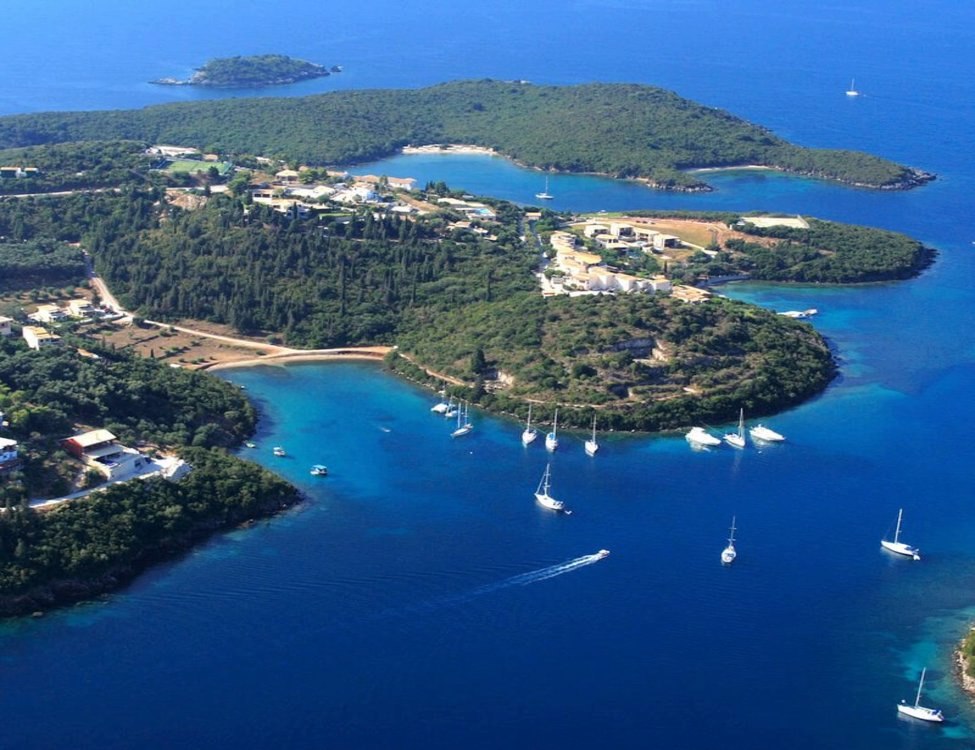
- Most desired beaches:
The nearest beach is Petritis beach, which is located right in front of the village but far away from the main road. This small sandy beach has relatively shallow waters, which makes it ideal for families with small children. The beach also has public showers and washrooms, as well as many fish taverns for visitors to grab a nice, fresh meal after a long swimming session. Boukaris beach, located a bit south from Petritis, is one of the cleanest beaches in Corfu. This beautiful beach is essentially made of numerous small consecutive bays with sand and pebbles and is widely popular among both locals and tourists for its mesmerizing scenery. However, the most popular beach in southern Corfu is probably Kavos beach, around 6 nautical miles south from Petritis. This gorgeous sandy beach is fully equipped with a wide range of facilities, which can ensure a nice stress-free time for holiday-goers. The waters are very clear, turquoise, and relatively shallow, making it perfect for families with small children. - Berthing:
The only berthing option available for visiting yachts is along the breakwater quay, where around 8-10 yachts can moor bow-to or stern-to using their anchors. Depths are at least 3 meters along this section. However, you’ll be dropping anchor at a depth around 2.25 – 2.5 meters in the center of the harbor. Holding is good in mud and weed. It is also possible to moor stern-to the outer end of the breakwater. Depths here are 3 meters for the first 20 meters from the end but shoal very quickly to 1 meter after that. The shelter is good in winds from W round to NW, but become untenable when strong winds from NE round to S blow. - Anchorage:
Visiting yachts can also anchor in the SE bay of the harbor, with depths around 3.0-7.0 meters. Holding is excellent in sand and weed. The shelter is reasonable in prevailing NW winds, however, anything strong from E or S can make the anchorage untenable.
Day Three: Paxos

- Most desired beaches:
Located on the southern tip of the island, Mongonissi is the only sandy beach in Paxos. The beach is well-equipped and offers many water-sport options, making it highly popular for tourists. Another fashionable beach is Monodendri, which is located around 1km north of Loggos. This white pebble beach is also one of the largest beaches on the island, offering a wide range of facilities for tourists, including lidos, bar and tavern. For more dramatic scenery, we suggest visiting Eremitis beach on the west coast of Paxos. Surrounded by perpendicular white cliffs and turquoise water, this lovely pebble beach is a delight for those who love swimming in wild nature. Or, you can also visit the islet of Antipaxos for the legendary Virka beaches. Known for its perfectly soft white sand and Caribbean-blue water, the beach is often deemed as one of the most beautiful in the region. - What not to miss:
Gaios is the largest town of Paxos, and also the capital of the island. The seaside town charms visitors with its Venetian architecture, stylish neoclassical buildings in faded burgundy and pale ochre, and a maze of lovely cobbled streets. The town also hosts the only night club on Paxos island, as well as a wide range of waterfront bars that light up the island’s nightlife. Another interesting town to visit on Paxos is Lakka, a beautiful village situated on the northern tip of the island. Surrounded by lush green olive groves, this picturesque village is built around a large aquamarine bay, where boaters can often find many flotillas mooring. It is also a great spot for water skiing and scuba diving. If you have a bit more time to explore, we would also recommend set sail to the islet of Antipaxos, which is only around 3 nautical miles from Gaios port. The islet is known for its beaches, with fine white sand, exotic turquoise waters, and many lovely tavernas. Visitors to the islet will also be delighted by the distinct taste of local wine. - Berthing:
1. Port Gaios (39°12.230’N, 020°11.470’E) is the main harbor of Paxos, which is located over halfway down the NE coast. The North Quay offers moorings for 20 – 25 yachts in depths of 2.5 meters at the quay. Depths in the channel are around 6 – 8 meters, with good holding in mud and weed. The West Quay offers moorings for 8 – 10 yachts in depths of 2.5 – 3 meters. Holding is good in mud, but it is advisable not to lay out too much chain as tripper boats and other yachts using section X can lay over you. The South Quay is shallow and occupied mostly by small fishing boats on laid moorings. However, the first 60 meters of the quay is reserved for boats from 10 am to 5 pm. The D.Quay offers anchor moorings for 12-14 boats in depths of 2 meters. In general, shelter in the harbor is excellent in most conditions, although strong SE winds can make the S part of the harbor very uncomfortable.
2. Port Lakka (39°14.320’N, 020°08.020’E) is situated at the NE tip of Paxos. The Main Town Quay offers anchor mooring for 10-12 yachts in depths of 2 – 2.5 meters at the quay. Depths further out, where yachts drop anchor, are around 4 – 5 meters. Holding is good in sand and weed. The E Side Quay offers anchor mooring for 2-3 yachts, preferably bow-to, since the depths are mostly little more than 1.5 meters. The Shallow E Quay offers anchor moorings for 3-4 yachts, preferably bow-to, as depths are just 1.25 meters and gets shallow towards the corner. - 3. Port Longos is a small harbor lies between Lakka and Gaios on the E coast of Paxos island. There is a small space on the S side for 6 boats anchor moor. Otherwise, boaters can free anchor with care in the middle of the harbor. Depths here are a little more than 3-4 meters, with good holding in sand and weed. The shelter is acceptable, although prevailing NW winds can make it very uncomfortable.
Day Four: Parga

- Most desired beaches:
The most popular beach in Parga is probably Valtos beach, just 20-minute walking from the town. The beach is a large, 3-kilometer long stretch of small, soft pebbles surrounded by lush green vegetation and crystalline, deep waters. It is very well-organized, offering a wide range of services for tourists, as well as many different water-sport options, including jet-skiing, canoe, pedaloe, and even banana rides. Around 4km south from Parga town is the beach of Lichnos, another beautiful beach that we’d recommend. Unlike Valtos, the beach in Lichnos is sandy, with some large pebbles. The beach is covered by green olive trees, with water so deep and clean that you can even fish here. Aside from tourists facilities, there is a wide range of water-sports for visitors to participate, including diving, scuba diving, jet-skiing, surfing, and snorkeling. Lichnos is also known for having the Cave of Aphrodite, which is only 5 minutes sailing away. If you’re looking for a calmer option, we’d suggest set sail to Sarakiniko beach, located around 12km away from Parga. Since it is not as popular as other beaches in the area, this picturesque beach often has a peaceful, tranquil vibe. Tucked between the hills and surrounded by lush green olive groves, Sarakiniko also has some lovely taverns that offer visitors tasty dishes signature to Greek cuisine. - What not to miss:
The 11th-century Venetian castle is the region’s most important architecture and historical symbol. Initially built to protect residents of Parga from pirates and Turks, the castle sits on top of a hill, open up a magnificent view over Parga Bay and the open sea. After suffering from decades of destruction, nowadays, visitors to the castle can still see some architectural details that reflect its historical values, including the Lion of Venice at the entrance, emblems of Ali Pasha, and two-headed eagles. There’s also a secret path to the sea, so make sure to look for it 😉 Some other worth-visiting sights in Parga include the 19th-century castle of Anthousa, the Church of Panagia, the Olive Oil Factory where you can see the process of olive making using traditional tools, and the Ecclesiastical Museum with many valuable items to the town’s history. For nature lovers, make sure to check out the springs of Acheron River, known for its magnificent natural beauty with the rocky landscape, transparent water, and an ecosystem that is recognized and protected by the Natura 2000 Network. In ancient Greek mythology, Acheron is one of the five rivers of the Greek underworld, which also contributes to the sight’s popularity among visitors. - Anchorage:
Anchorage is available in the NW corner of Ormos Valtou. Depths here are around 4-5 meters with goof holding in sand and weed. The shelter is good in prevailing NW winds, although strong S winds can make it untenable. Wash from local boats, ferries, and high-speed water-sports can also make it rather uncomfortable to anchor during the day. Alternatively, it is also possible to anchor in the small cove E of the Venetian castle. However, from June to September, this cove is a popular beach, so yachts are not welcomed. Depths here are from 4 – 5 meters, with good holding in sand.
Day Five: Sivota
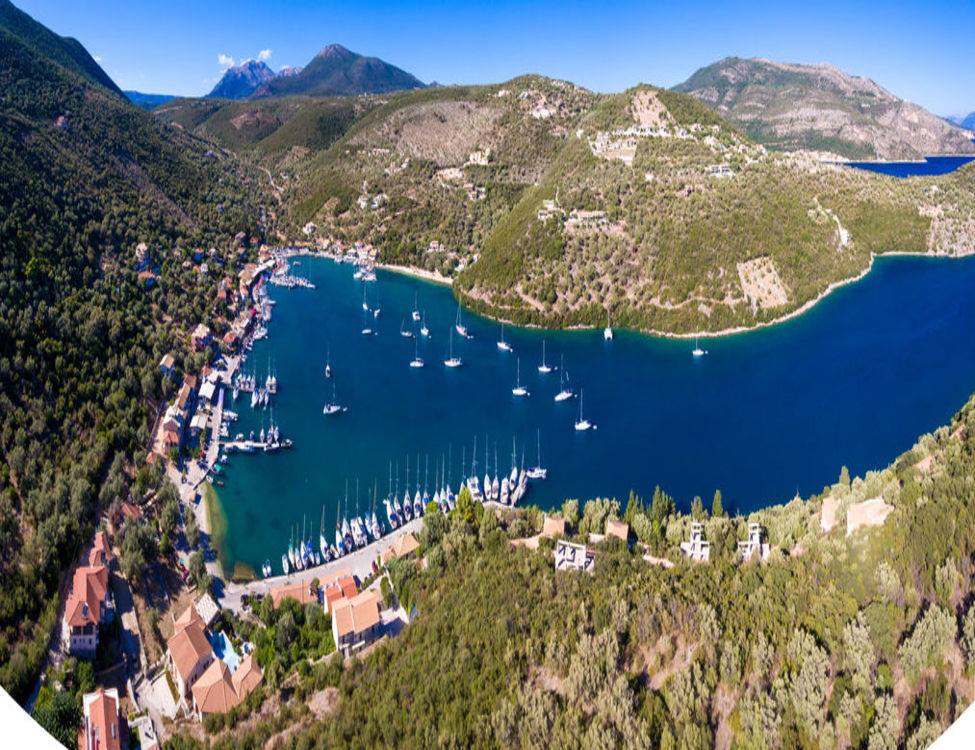
- Most desired beaches:
One of the most famous beach in the area is Pisina, located on the islet o Agios Nikolaos. The beach is a long stretch of fine white sand, covered in lush green surroundings and very clear, emerald sea, making it a top destination for beach lovers. Another top-notch beach is Mikri Ammos, about 2.8km away from Sivota. The beach is well-organized with many facilities for tourists. Water is a bit colder here, but still very clear and has rich sea life, making it a great destination for snorkeling and scuba diving. However, due to its size and proximity to Sivota, it can get crowded during high season. - What not to miss:
We recommend making small trips to visit some nearby islets around Sivota, including Mavro Oros, Agios Nikolaos, and Mourtemeno. For history lovers, make sure to check out the ancient settlement of Vrachonas in the southwest of Sivota. The settlement consists of about 50 ruined houses dating back to the 18th-19th century. Also, don’t miss out the springs of Acheron River, known for its magnificent natural beauty with the rocky landscape, transparent water, and an ecosystem that is recognized and protected by the Natura 2000 Network. In ancient Greek mythology, Acheron is one of the five rivers of the Greek underworld, which also contributes to the sight’s popularity among visitors. - Berthings:
There are 4 berthing options in Sivota:1. The W Quay (38°37.434’N, 020°40.928’E) is a stretch of quay extending N from the beach up to the head of the bay. It offers anchor moorings for 30-35 yachts in depths from 1.5 – 2 meters. Holding is moderate to good in sand, mud, and weed. The shelter is good in general, except when strong S and SE winds blow
2. S Quay (38°37.312’N, 020°41.012’E) extends from the E side of the beach. It offers anchor moorings for 15-20 yachts in depths from 3 – 3.5 meters. You will be dropping anchor in depths of 8 – 12 meters off the way, and it is advisable to use plenty of chains as holding is quite moderate. The shelter is good in settled weather but can get uncomfortable when NW winds blow.
3. Yacht Bar pontoon (38°37.457’N, 020°40.973’E) is located at the NE corner of the harbor. It offers moorings for 20-25 yachts in depths of 2-3.5 meters. Water and electricity are available on the pontoon.
4. W Quay pontoon is located at the N end of the W quay. It offers moorings for around 20 yachts using mooring lines supplied. However, the lines are quite short, so they’re unsuitable for yachts over 11 meters. Depths at the pontoon ranging from 2.5-3.5 meters. Water and electricity are available at the pontoon. There’s also wifi and showers at the taverna.
Day Six: Kalami
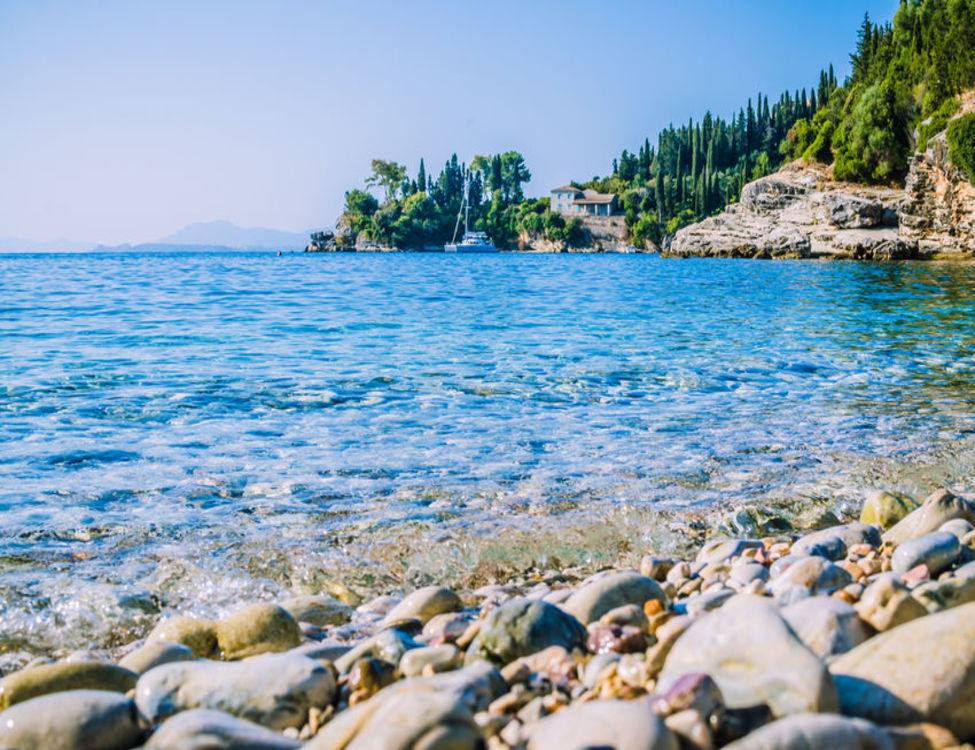
What not to miss:
Another serene destination for you to skip the crowds on the high season is Kalami Bay, located at the northeastern side of Corfu. The beauty of this area is made known to the world through its appearance on several TV shows and movies, especially the BBC’s 2005 movie “My Family and Other Animals”, which was made based on the famous book by Gerald Durrell. However, despite its increasing fame, Kalami Bay still manages to maintain its peaceful ambiance and beautiful landscape. The area charms visitors with its unique rock formations, lush green olive groves, and incredibly sapphire blue waters. The bay has received a prestigious Blue Flag title for its gorgeous beach, with many facilities for tourists, white pebbles and crystal clear waters. There are also many water-sport options for those who would like to have a bit of adventure.
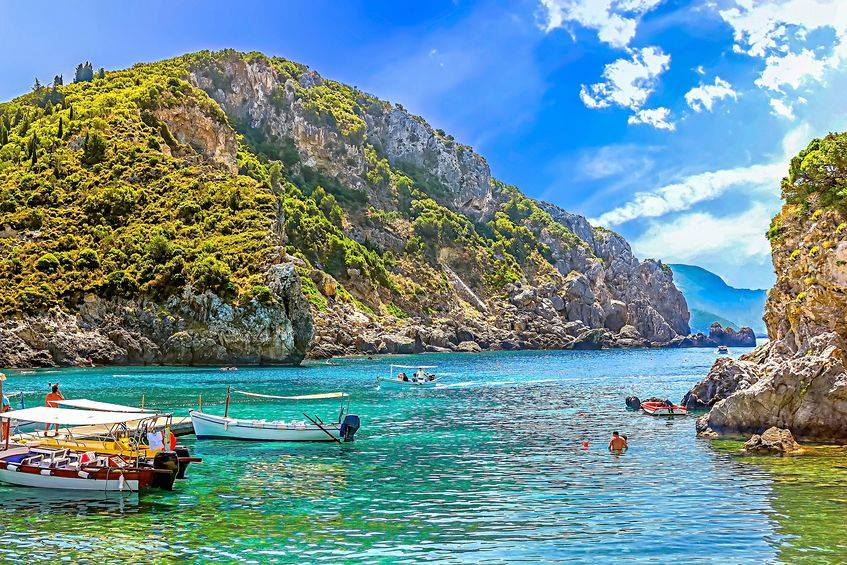
Leave a Reply